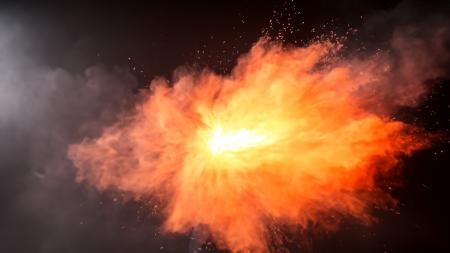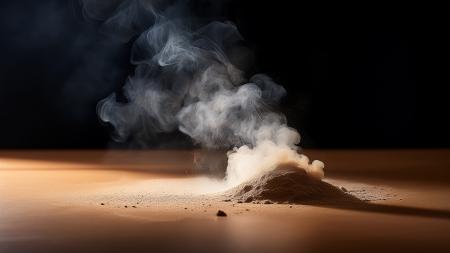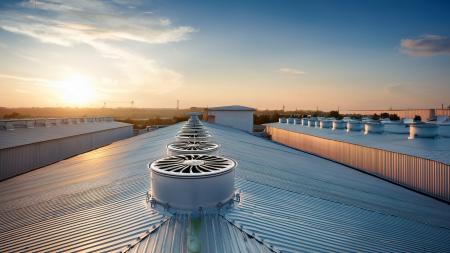This article discusses the key factors of dust explosion hazards such as:
- Legislation
- Ignition
- Danger zone classification
- Ventilation - removal of dust layers
- Dimensions of the danger zone
The experts at Dinnissen Process Technology are available to answer all your questions:
Get in touch with Juul Jenneskens 077 467 3555
Legislation
There are many companies that work with flammable substances in solid form, such as granules and powders. Dust is often released during the processing or transport of these substances. These are particles with a size smaller than 0.5 mm. When dust is released, attention must be paid to the prevention of fire and the occurrence of a dust explosion. Preventing this is a matter of ensuring that the combustible substance cannot come into contact with air. In the event that this is not possible or if the combustible substance is nevertheless mixed with air, it must be ensured that there is no ignition source that could initiate an ignition and / or an explosion.
In the Netherlands, there are health and safety regulations that prescribe rules with regard to the safety of the workplace and the machines and installations located at this workplace. In the event that a situation may arise with explosive atmospheres, Article 7 of Directive 1999/92 / EC from the Working Conditions Act applies. This article prescribes that the employer must then determine a danger zone classification.
If it concerns a situation with flammable gases and thus the risk of a gas explosion, the practice guideline NPR 7910-1 applies. Practice guideline NPR 7910-2 applies to situations where there is a risk of a dust explosion. This practical guideline is derived from the obligation formulated in the NEN-EN-IEC 60079-10-2 standard to draw up a danger zone classification if there is a risk of dust explosions in the company.
Ignition
A combustible substance consisting of fine particles, such as flour, sugar or coal dust, can swirl upwards and mix with air. A cloud-like dust cloud is created that can be explosive. Sometimes there is also a hybrid mixture. In that case, the dust cloud has mixed with a flammable gas. Hybrid mixtures are extra dangerous. They can explode already at low concentrations. Hybrid mixtures are also easily ignitable and the reaction is often very violent. An example is soybean dust where the soybean substance is mixed with hexane released from the soybean.
If a dust cloud forms, for example when dumping bulk goods, the substance mixes with air. The dust-air mixture can ignite and cause a dust explosion. The pressure wave that arises from this explosion often whirls up even more dust, which is again mixed with air. This can then cause a so-called "secondary" pressure wave. The secondary pressure wave is often even more powerful than the "primary" explosion. This mechanism can take place several times in a row.
The dust explosion may also cause fires in the dust that did not participate in the explosion or in the material from which the dust originates.
At least a certain amount of energy is required to ignite a dust cloud. This is called the minimum ignition energy. A dust cloud can be ignited if it comes into contact with a hot surface. The lowest temperature of a vertically standing surface to ignite a dust cloud is called the minimum ignition temperature.
Oxygen is needed to burn flammable substances. Normally this oxygen is obtained from air. Below a certain amount of dust it is not possible to ignite the dust-air mixture. The mixture is then too lean. This limit has been given the name “lower explosion limit”, also known as Low Explosion Level (LEL), with g / m3 as the unit. For a large number of organic substances, this lower explosion limit is in the range from 50 g / m3 to 100 g / m3. If the exact value is not known, it is often assumed that there is a risk of explosion above a LEL of 20 g / m3.
If a layer of dust is deposited on a warm surface, ignition can occur at a temperature significantly lower than the LEL. The lowest temperature at which this can occur is called the smoldering temperature. This smoldering temperature is determined for a 5 mm thick dust layer on a warm plate. A thicker dust layer can ignite at even lower temperatures. Prior to smoldering, heating can also occur in a dust layer. This ensures that the temperature in the dust layer rises and the smoldering temperature and / or the LEL are reached more quickly.
Theoretically it is also possible that the dust-air mixture contains too much combustible dust. In that case the mixture is too rich. This is also called the Ultimate Explosion Level (UEL). Above the UEL there would actually no longer be an explosion, but because dust-air mixtures are generally not homogeneous, areas in the dust cloud often occur that are below the UEL limit. An explosion can still occur in those areas.
Fire, smoldering and heating are indirect causes of ignition and an explosion. Electric currents, electrostatic charging and mechanical mechanisms can cause sparks and thus directly explode a dust-air mixture. The most relevant ignition sources for dust explosions are hot surfaces, flames, spontaneous combustion, mechanical sparks, welding sparks, electrical installations and static electricity.
In terms of explosiveness, a gas-air mixture has different properties than a dust-air mixture. A gas-air mixture mixes better and is more homogeneous than a dust-air mixture. Decisive for the combustion of a gas-air mixture are the flow rate of the combustible gas, its density and the ventilation present. A dust-air mixture can only become explosive if it is mixed with air in a turbulent manner. Furthermore, a dust layer is a latent hazard. At any "random" moment, the dust can whirl up and form an explosive dust cloud.

Deflagration explosion

Smoldering hazard
When dust is released, attention must be given to the prevention of fire and the occurrence of a dust explosion
Danger zone classification
In companies where there is a risk of explosion as a result of dust clouds, a hazard zone classification is mandatory. This classification can be determined via the step-by-step plan below.
Step 1: Determining whether a hazard zone classification is necessary. This depends on whether flammable dust is present, whether it concerns the inside of an appliance and whether there is more dust than the lower explosion limit.
Step 2: Determining the nature of the danger zone. Answers must be given to the questions “What is the nature of the hazard sources?” “Is there local exhaust ventilation?”, “Can a layer of dust form?” and "Is the dust layer removed by cleaning?"
Step 3: Determining the size of the zone. It is important whether the dust migrates, how the dust spreads and whether the dust layer is always removed by regular cleaning.
Classification is only useful and mandatory if more than the minimum amount of combustible material is present or can be released. If there is less than 0.1 kg of dust (with a particle size less than 0.1 mm) and less than 1 kg of combustible dust (with a particle size between 0.1 mm and 0.5 mm) present within an appliance, no danger zone classification has to be made. This also applies to dust in a building, if in that case less than 50 kg combustible dust (with a particle size smaller than 0.1 mm) and less than 500 kg combustible dust (with a particle size between 0.1 mm and 0 , 5 mm) is present.
The class of a zone is determined by the nature of the hazard sources, The nature is determined by the frequency and duration of the explosive conditions, the nature of the dust layers, which is equal to the frequency and duration of their presence, the local ventilation conditions and the degree of cleaning.
More often, part of the process is provided with a dust cover. No dust escapes from the dust jacket, so that the other process parts remain dust-free. The dust envelope must form a safe boundary beyond which the hazards are limited.
There are various types of hazard sources that influence the hazard zone classification. The classification first of all depends on the frequency and the period of time that dust-air mixtures can be present:
Continuous cloud formation: the dust cloud is present continuously or more than 10% of the operating time. This applies first of all to places within the dust envelope. Examples are cyclones, mixers, mixers, dust extractors, powder conveying systems.
Primary Hazard Source: The dust cloud is present for 0.1 to 10% of the operating time. This is especially true for areas immediately outside the dust enclosure, for example in places where dust can accumulate or in the vicinity of bag filling installations.
Secondary hazard source: the dust cloud is present for less than 0.1% of the operating time. As an example, the areas where bags of powdered products are stored and the areas where a manhole is occasionally opened from which dust can escape.
The second starting point for the hazard zone classification is to determine whether it is possible that dust layers can form. In principle, only minimal danger can arise if cleaning is done regularly. If cleaning and removal of dust layers is covered by installation management and maintenance plans, only secondary dust explosions can occur.
Ventilation - removal of dust layers
By ventilating well it is possible to remove released dust. Obviously, ventilation should be especially active where dust clouds can reach. For this reason this is referred to in the standard as artificial local ventilation. The following distinction is made with regard to ventilation:
- Sufficient: failure of the ventilation is automatically detected. After that, recovery will take place as soon as possible.
- Good: ventilation is ensured by a double version.
- Good with absolute guarantees: ventilation is guaranteed by a double implementation + the provision of an independent energy supply.
The term "large building" is used in the hazard zone classification of a gas explosion hazard. This term does not apply to the hazard zone classification for dust explosion hazard. When one speaks of the ventilation conditions of a building, a "closed building" is meant.
Dust layers will generally not be removed by a ventilation system. Regular cleaning is necessary for this. The frequency must be so high that a dust layer thickness of more than 0.1 mm can never form. Preferably, dust layers should be removed with damp cleaning material. Hard brooms and compressed air are not used for cleaning. If vacuum cleaning installations are used, these must be central installations equipped with electrostatically conductive hoses and nozzles.
Three levels have also been defined with regard to the removal of dust layers and the clean household:
- Good: the thickness and thus the duration of the dust layers are kept at a negligible level.
- Sufficient: Dust layers are not negligible, but they are short-lived (less than 8 hours).
- Bad: Dust layers are not negligible and not short-lived (more than 8 hours).

Industrial air ventilation

Name: Juul Jenneskens
Advisor
Please feel free to contact me if you have any questions about this subject. My team of colleagues and I are ready to answer!
Get in touch with Juul Jenneskens 077 467 3555 [email protected]
Do you prefer to request a consultation directly?
